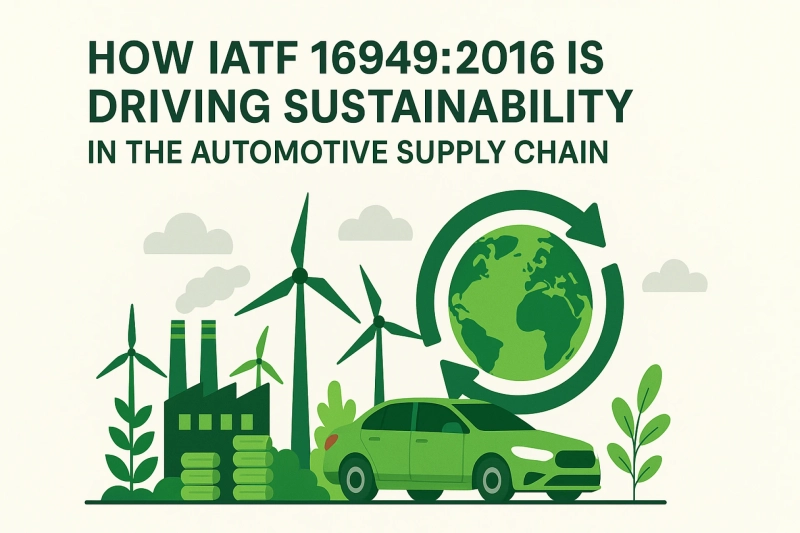The global automotive industry is under pressure—not just to meet quality and safety standards, but to reduce its environmental footprint and embrace more sustainable practices. While much of the sustainability spotlight falls on electric vehicles and carbon-neutral factories, a quieter transformation is happening within automotive supply chains, driven by quality standards like IATF 16949.
At first glance, IATF 16949:2016, the international quality management standard for automotive production, may seem focused purely on compliance, consistency, and defect reduction. But dig a little deeper, and you’ll find that it plays a growing role in shaping more sustainable, efficient, and environmentally responsible operations.
What Is IATF 16949?
IATF 16949 is a technical specification generated by the International Automotive Task Force (IATF) in partnership with ISO. It extends ISO 9001, which is the world quality management standard of the day, and introduces additional requirements, adapted to the auto industry.
Key goals include:
- Reducing variation and waste in the supply chain
- Ensuring product quality and safety
- Enhancing customer satisfaction
- Standardizing quality management across regions
For many Tier 1 and Tier 2 suppliers to major automotive OEMs (Original Equipment Manufacturers), certification to IATF 16949 is required. The standard is for any organization that manufactures parts, components, or assemblies for the automotive industry.
Sustainability: Not a Direct Requirement, But an Emerging Focus
Interestingly, IATF 16949 does not directly require organizations to meet sustainability goals or report environmental performance. However, it indirectly supports sustainability in several ways:
1. Waste Reduction and Process Efficiency
One of the main pillars of IATF 16949 includes process efficiency, which in its turn, leads naturally to smaller material wastage, lower energy consumption, and a usage of the resources in their best part. Lean manufacturing principles, embedded in many IATF-compliant systems, provide for savings in the environment and money.
For instance, a range of continuous improvement processes such as FMEA (Failure Mode and Effects Analysis) and PPAP (Production Part Approval Process) guarantee early defect identification with consequent reduction of rework and scrap rates—a huge part of environmental victory.
2. Risk-Based Thinking and Lifecycle Perspective
Although ISO 14001 (the environmental management standard) addresses environmental risks directly, IATF 16949 demands a risk-based approach to quality and supply chain management. Such a mindset can be applied when examining environmental risk, especially when many more OEMs are asking suppliers to show evidence of lifecycle sensitivity of their products from (grown) raw materials right through to end-of-life disposal.
Some suppliers are already using their IATF risk assessments to add the metric of carbon risk, the sourcing of raw materials, and energy use, even if it isn’t mandatory at the moment
3. Supplier Development and Accountability
IATF 16949:2016 works for a good relationship with suppliers and upstream responsibility. Certified organisations need to assess how their suppliers perform, and they must request corrective measures where appropriate.
This enables the opportunity to incorporate green procurement policy under which environmental performance is a parameter in the evaluation of suppliers. It is Gary Daughters from I Fleefing who breaks the news to the OEMs that more of these are putting environmental requirements into quality agreements, with IATF systems used to enforce the stipulations.
4. Data-Driven Decision Making
Suffice to say, the standard is very data and metrics-focused, bearing high marks regarding performance analysis. This analytical base allows firms to measure energy consumption, emissions, and waste at the same level of rigor as defect rates and production KPIs—a critical function for firms on the path to ESG (Environmental, Social, Governance) reporting.
Case in Point: A Tier 2 Supplier’s Green Turnaround
Consider the example of a Tier 2 plastics manufacturer in Eastern Europe supplying interior components to German automakers. In pursuit of IATF 16949 certification, the company mapped its production processes, identified inefficiencies, and introduced a continuous improvement plan.
During this exercise, they noticed that a key molding process consumed excessive energy and produced high levels of off-spec material. By refining the process using IATF tools like root cause analysis and corrective actions, they:
Reduced plastic waste by 40%
Cut electricity usage by 15% per part
Lowered their carbon footprint per unit by 18%
Though their goal was quality compliance, the environmental benefits became a competitive advantage. Their OEM clients took notice and awarded the supplier new contracts based on their improved sustainability metrics, achieved without any formal environmental certification.
The Road Ahead: Will IATF 16949 of Automotive Supply Chain Include Formal Sustainability Requirements?
By 2025, the IATF 16949 is not going to be officially revised, such that incorporating sustainability or ESG compliance will become a formal clause. However, the industry observers see that future updates may incorporate climate-related disclosures, ethics sourcing, and energy performance, particularly with the increase of regulatory and customer pressure.
While waiting, visionary corporations are already harmonising their IATF processes towards meeting the requirements of ISO 14001 as well as ISO 50001 (Energy Management) and other sustainability schemes. The goal: to create a system to deliver all excellence, compliance, and climate responsibility—in one go.
Conclusion
IATF 16949:2016, a globally recognized quality management system custom-made for the auto industry, never got sold as a “Green” standard, but the impacts on sustainability of which it is subtly increasing. A foundation for responsible and environmentally conscious automotive manufacturing, it encourages efficient processes and robust supplier control and risk-based thinking.
While sustainability becomes a non-negotiable part of doing business, the organizations that will leverage IATF 16949 creatively will not only meet quality expectations – they’ll gain a competitive advantage in the green automotive economy.



